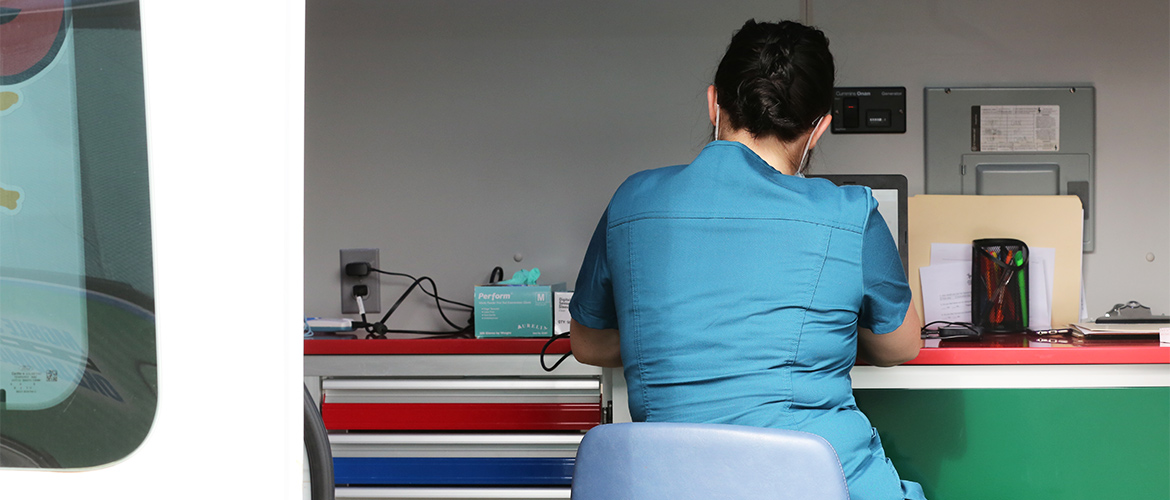Newsroom | Community Health

HCSC Mobile Care Programs Extend Reach into New Communities
Mobile health clinics are vital for rural and underserved communities that lack primary care options, transportation to health centers, insurance coverage, and other resources. For some people, such clinics are the only means to accessing medical treatment.
Health Care Service Corporation (HCSC) helps communities overcome problems obtaining care by delivering preventive services, basic dental care and educational outreach through its mobile health programs. HCSC’s health plans in Illinois, Montana and New Mexico recently added new, upgraded vehicles to reach more people and eliminate gaps in care.
“The public health data showed us there were a lot of unmet needs within our communities,” says Clarita Santos, HCSC executive director for corporate and civic partnerships. “In order to address those needs we knew we needed to increase some of our mobile care services.”
For years, HCSC has worked with mobile health programs in its five plan states — Illinois, Montana, New Mexico, Oklahoma and Texas — to deliver immunizations and other vital health services to underserved regions.
“These communities cannot come to us, so we need to go to them."
Last year, 28 total vans served more than 58,000 clients and provided more than 54,000 immunizations and nearly 41,000 other health services. In the first half of 2022, the entire fleet reached more than 25,000 clients and provided over 47,000 health services.
HCSC works with community organizations, public health departments, food pantries and other nonprofits to identify high need areas. By covering the costs of certain medical services, local organizations can provide preventive screenings, mental health assessments and immunizations inside vans parked at local churches, nursing homes and other facilities.
The ongoing effort has helped bring much-needed care to people in new ZIP codes.
In Illinois, for example, a third van will address longstanding health needs in Waukegan and northern Lake County, while the other vehicles — one in Springfield and another in Chicago —continue providing COVID-19 vaccines to local neighborhoods.
“These communities cannot come to us, so we need to go to them,” says Annet Miranda, associate director of community at Erie Family Health Centers in Waukegan, a longtime partner of the Illinois plan.
Montana added a second vehicle to its fleet last year to reach the remaining 13 of 56 counties it has yet to work in. The new vehicle has already helped establish relationships in Carter County, the seventh least-populated county in the state. And the program’s partnership with nonprofit Smiles Across Montana, or SAM, is helping address gaps in dental and oral health care.
“We’re working together to integrate medical and dental care and exploring innovative ways to address those needs for the community,” says Crystal Spring, a registered dental hygienist who co-founded SAM in 2018.
Kamille Kirchberg, administrator for Montana’s program, expects the new resource to have an outsized impact across the state.
“With a single large van, we typically serve more than 6,000 people and cover 25,000 miles each year,” she says. “With the second van, we’re expecting to almost double that at the very least.”
Working with local nonprofits is critical to addressing social determinants of health, such as transportation and access to affordable care, that affect health care outcomes, Santos says.
“When you partner with other organizations and you’re able to share collective knowledge and expertise and then execute, those resources become 10 times as impactful,” she adds.
New Mexico’s mobile care program and its partner since 2011, Southern New Mexico Diabetes Outreach (SNMDO), exemplify that effect.
In 2021, the program worked with organizations such as SNMDO to administer nearly 1,400 health screenings and more than 1,100 vaccinations.
This year, the mobile fleet will include a new, upgraded vehicle with enhanced internet capabilities for conducting telehealth visits in remote regions and a wheelchair lift to help SNMDO screen people with disabilities.
“The van brings a professional, mobile clinic atmosphere that makes people feel comfortable,” says Selena Gomez, SNMDO’s screening and media director. “We let them know that we're offering these tests for free, and people more often accept our services.”
Mobile services were critical during COVID-19
When COVID-19 first hit the U.S. in 2020, HCSC mobile health workers were among the first on the front lines.
Employees collaborated with clinical care teams and local public health departments to better understand the coronavirus and navigate guidance from the Centers for Disease Control and Prevention. Mobile programs redirected resources to needy areas and helped educate communities about the virus, and later the vaccines.
Looking back on the effort, Santos says the mobile health teams were crucial to calming fears and spreading awareness.
“I’m pretty proud of how brave everybody was,” she says.
In 2021, HCSC provided more than 23,000 free COVID-19 vaccinations to people across its five plan states. The programs continue to vaccinate communities, administering more than 3,800 COVID-19 shots in the first half of 2022.
